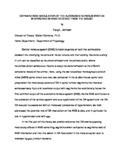Dopaminergic modulation of the autonomic nervous system: in vitro and in vivo evidence from the mouse
Author
Johnson, Tracy L.
Abstract
Central nervous system (CNS) function depends on both the connections between the underlying neurons and neural circuits and their activity. Neuronal activity in turn can be classified as neurotransmission and neuromodulation, where neuromodulation serves as a means to adapt neurotransmission to the different behavioral needs of the animal. Here, using the well-described monosynaptic stretch reflex (MSR) spinal circuit as a tool, we compared in the in vitro mouse spinal cord preparation the modulatory actions of DA in spinal lumbar segments that mediate somatosensory input and locomotor output with segments that additionally house the final common output of the autonomic nervous system (ANS). As the ANS contributes to the activation of the cardiac system and as a dysfunction of the DA system and the DA D3 receptor is associated with an increased prevalence of hypertension, we next addressed the potential role of DA modulation on the ANS in vivo, and in particular its role in hypertension and with age. In the first part of this thesis, we provide evidence that DA exerts opposing modulatory effects in ANS-containing segments when compared to segments void of ANS innervation and that this switch in DA modulation in the thoracic spinal cord is reversed by gap junction blockers. In the second part of the study, we show that aging-related increases in blood pressure and cardiac function in control wild-type (WT) animals were accompanied by bradycardia in the oldest animals. Interestingly, young D3 receptor knockout (D3KO) mice displayed blood pressure and heart rate values that were significantly increased over their age-matched WT controls but similar to those of the old WT group. Ultrasound echocardiography revealed aging-related increases in heart ventricle size in WT animals, but no similar changes in D3KO. In contrast, functional analyses revealed that ejection fraction and fractional shortening were compromised in old WT animals and similar to young D3KO mice. Subsequent histological assays demonstrated an aging-related interstitial fibrosis that peaked in old WT and that was similar to old WT in young D3KO mice. Taken together, our data suggest that DA-mediated neuromodulatory actions of spinal cord circuits are dependent on the underlying spinal circuitry, and they suggest that a dysfunction of the D3 receptor pathway is sufficient to mimic the increased hypertension and cardiac remodeling observed in the aging heart.
Date
2012
Citation:
APA:
Johnson, Tracy L..
(January 2012).
Dopaminergic modulation of the autonomic nervous system: in vitro and in vivo evidence from the mouse
(Master's Thesis, East Carolina University). Retrieved from the Scholarship.
(http://hdl.handle.net/10342/4015.)
MLA:
Johnson, Tracy L..
Dopaminergic modulation of the autonomic nervous system: in vitro and in vivo evidence from the mouse.
Master's Thesis. East Carolina University,
January 2012. The Scholarship.
http://hdl.handle.net/10342/4015.
June 29, 2024.
Chicago:
Johnson, Tracy L.,
“Dopaminergic modulation of the autonomic nervous system: in vitro and in vivo evidence from the mouse”
(Master's Thesis., East Carolina University,
January 2012).
AMA:
Johnson, Tracy L..
Dopaminergic modulation of the autonomic nervous system: in vitro and in vivo evidence from the mouse
[Master's Thesis]. Greenville, NC: East Carolina University;
January 2012.
Collections
Publisher
East Carolina University

